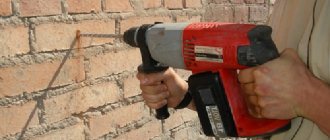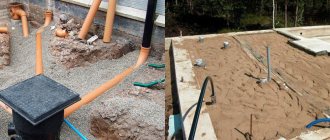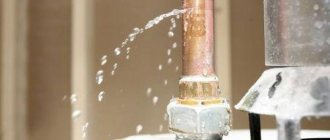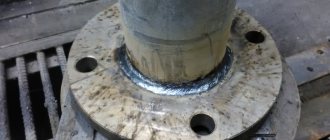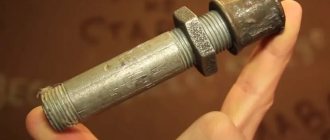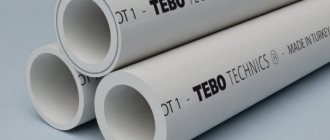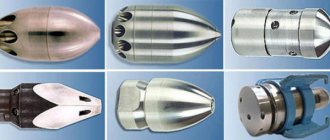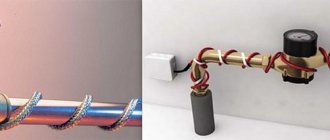How to properly drill a hole in a pipe?
Drilling holes in pipes is a fairly simple task that can be done even without specially designed machines or other complex tools. However, before drilling a hole in any pipe, you need to, firstly, understand the features of drilling, and secondly, study the safety rules. The best place for drilling is a garage or some other suitable room for this. Punching and drilling holes must be carried out by a master exclusively wearing protective gloves and goggles. The drill must be checked for sharpness and be sure to securely fasten it.
It is advisable to drill holes in pipes on a workbench, since careless handling can damage the surface of the table.
General recommendations for drilling pipes of all types
Prepare tools that will help you drill a hole in the pipe:
- Drill with a drill of suitable diameter.
- A block of wood.
- Vise.
- File.
- Hammer.
Depending on what material the pipe in which you need to drill a hole is made of, the work may require the use of additional devices and have a number of differences. However, there are several general requirements, rules and recommendations, following which you can drill a hole in a pipe made of any material.
To drill a hole in pipes, you will, among other things, need a wooden block. Select a product of such dimensions that its horizontal line is the same as the outer diameter of the pipe being processed. The vertical should be approximately 50-100 mm. Drill a through vertical hole with the required diameter in the block. Clamp the block with the pipe in a vice. The block must be clamped from above, and the pipe being processed from below. The prepared hole in the wooden block will serve as an elementary guide. Thanks to it, the drill will not be able to move to the side during operation. Take a drill, insert the drill bit into the hole and get to work. Although manipulating the block will take some of your time, it will save you from problems with symmetry in the future. With a block you can't do absolutely anything other than make a straight and neat hole.
While drilling, you should try not to move the drill to the sides. Because of this, the hole the hole will become uneven . In just a few minutes the required hole in the pipe will be ready.
In some situations, it becomes necessary to bore the prepared hole. This operation can be successfully performed using a round file. However, using a file will require you to spend a lot of time and effort. It is much easier to prepare a drill of a larger diameter and use it to create a suitable hole.
Diagram of drilling holes using a simple wooden jig.
Sometimes you need to make a square hole. This task requires a little more effort and some ingenuity. However, everything can be done with your own hands. First you need to prepare a round hole according to the diagram described above. After this, using the same file, you can give the resulting hole the desired square shape. Not only is the method quite painstaking, but it also does not allow the work to be completed with high accuracy. Therefore, in some situations, it is more advisable to use a square-shaped rod with the required diameter and, with its help, turn a round hole into a square one. Gradually the rod will do its job. At the end of the work, burrs may remain. They are very easy to get rid of using an ordinary file.
Thus, these simple tips and tricks will help you make the required number of holes in the required shape and size without any problems. The most important thing is to approach the matter with maximum responsibility and determination. It is also important to know that the drill will get quite hot during operation. And when heated, metal tends to expand. Therefore, it is necessary to periodically spray the drill with water: this will extend its service life and allow you to obtain a hole of the diameter required.
However, these are general recommendations. And due to the fact that the farm uses pipes from different materials, it is necessary to know about the processing features of each of them.
Measurements and calculations
On a roof with a ridge, the height is calculated depending on the interval between the pipe and the ridge:
- With an interval of 1.5 meters, the height of the pipe should be 0.5 meters higher than the roof ridge.
- With an interval of 1.5 to 3 meters, the ridge and pipe should be at the same level.
- If the interval between the pipe and the ridge is more than 3 meters, then the length of the pipe above the roof can be determined based on a line that runs at an angle of 10 degrees from the ridge run to the horizon.
Thermal insulation materials, waterproofing and vapor barrier should be at a distance of 15 cm from the brick or concrete chimney; if the pipe is a ceramic product, then the permissible distance is 25 cm.
Step-by-step instructions for processing cast iron pipe
Working with cast iron will require the use of the following tools:
- Drills and drill bits with pobedite bits.
- Marker.
- File.
There are two types of cast iron pipes. The first of them has both smooth ends, and the second has one of the ends smooth, and the second is equipped with a detachable connection. Before using pipes, be sure to ensure that the location chosen for them complies with approved building codes. It is better if there are no slopes or turns. Currently, cast iron is an indispensable material for the manufacture of a wide variety of products. Therefore, its drilling and cutting are very important operations.
By drilling cast iron it is necessary to understand the creation of holes using a device specially designed for this purpose, i.e. drill. Many craftsmen have to face this problem. And quite often they don’t know how to deal with it correctly. In most cases, gray cast iron is quite easy to machine, and when drilling into a pipe made of such material, there is no need to use lubricants and coolants. However, pipes may have their own characteristics. And in some situations you have to make more efforts.
To work with cast iron, choose a metal drill with an angle of about 118 degrees. If you do not have special tools for processing cast iron, proceed according to the following scheme: first take the smallest drill in diameter, prepare a hole, then place a drill of a larger diameter on the drill, make a new hole in place of the old one and continue this way until you have drilled to the required diameter.
If the drill starts to get very hot during operation, you can lubricate it with water. To drill cast iron in the absence of an electric drill, you can use a regular one, gradually increasing the speed. During operation, you need to drill at low speeds, without putting too much pressure on the drill.
For drilling at home, drills with pobedit bits are best suited. You need to work with them at low speeds, making sure to maintain vertical force. In addition, they require frequent cooling of the cutting attachment. Do not allow it to blacken or overheat.
Professionals in their field, as a rule, work on special machines and use working tools with appropriate sharpening. However, if you do not need to create holes in a cast iron pipe very often, there is no point in purchasing such a tool.
Due to the fact that when processing cast iron, fine chips and a large amount of dust are released, general safety recommendations should be followed during the work:
- The work area must have good ventilation.
- Drilling can only be done while wearing a respirator or at least a cotton-gauze bandage.
- When working, be sure to wear safety glasses with closed sides.
- You can only work with gloves, special clothing and preferably a hat.
READ How to Cut a Pipe Along
Choosing a sealant for chimneys
There are two types of sealant for installing chimneys:
Heat-resistant compounds are usually used to insulate the outer surfaces of stoves and fireplaces, as well as to insulate joints between brick pipes and roofing. It can also be used when installing sandwich pipes, but not made of metal.
Many sealants are based on silicone, with the addition of iron oxide, due to which such sealant is able to withstand constant temperatures from 250 to 350 degrees. Heat-resistant sealants can be acidic or neutral.
Heat-resistant compounds are used in cases where the constant heating temperature ranges from 1200–1300 degrees, and short-term heating reaches 1600 degrees. This sealant is used to seal cracks in stove fireboxes where there is an open fire and to seal chimneys on the roof. For cases with open fire, you need to choose fire-resistant compounds.
Heat-resistant pastes contain silicate. During polymerization, it is converted into an organosilicon compound that is extremely durable and 100% waterproof.
Features of working with plastic pipes
There are no difficulties with plastic pipes either. First you need to mark the drilling location on the pipe, then secure it, preferably in a vice, and position it so that it faces you. The pipe must be secured so that it does not move. This is why a vice is the most preferred option. However, be careful that the plastic does not deform under the influence of the applied forces.
Install a drill of the appropriate diameter on the drill. In this case you will need a guide. You can use a block, as in the previously discussed method. Turn on the drill at low speed and carefully, without displacement, begin to insert the drill into the pipe cavity. You can get rid of irregularities along the edges of the hole using a file or a sharp knife.
Making a hole with a square cross-section
To obtain a square hole, two methods are used.
- The first requires the use of a round drill and a file. To work, it is necessary to mark the area of the cutout and its center, after which small-diameter holes are first drilled, and then a cut is made along the marked boundaries and sanded with a file to an even cut.
- The second method is performed using a special nozzle, the cutting edge of which is made in the form of a Reuleaux triangle. During drilling, the axis does not remain in place, but moves along a trajectory describing a rectangle. This tool allows you to get a hole with smooth and parallel edges. The area of unprocessed corners is 2% of the cutout area.
Guide to Drilling Metal Pipe
Working with metal products in general and pipes in particular requires compliance with a number of rules. It should be borne in mind that if there is a need to create holes of large diameter, you must first use a drill with a diameter 1-3 mm smaller than planned and only then start working with a drill of the main size.
As with previous pipes, it is necessary to work at low speeds. To prevent chips from jamming the drill during operation, release them periodically. In order to increase productivity, professionals recommend working with a lubricant - machine oil if a hole is drilled in a steel pipe, and soap emulsion if copper is being processed.
To ensure that the pipe is securely fastened in the vise, you can install a nut between each side of the pipe being processed and the vise jaws.
In order for drilling to be as accurate as possible, use the block described earlier. If you wish, you can use a metal block with an M-shaped section and several pre-prepared holes of different sizes for drills. Instead, an ordinary wooden block with a pre-prepared hole the size of the pipe being processed and several different-sized holes will do. The drilling itself is performed as in previous cases, at low speeds, without swaying, shifting, etc. Happy work!
Varieties of elements for passing pipes through the roof
An example of how to simply and reliably close the gap between the roof and the chimney
Pass-through elements can be included in a set of pipes and this greatly simplifies the task of an inexperienced craftsman, since he only needs to assemble the parts together according to the instructions from the kit. If the chimney kit does not include a passage element, everything is a little more complicated, since you will have to select and purchase the necessary product yourself.
Installation is carried out in such a way that the upper part of the water seal funnel - a sealing ring made of heat-resistant elastic material - comes into direct contact with the pipe.
The water seal is attached to the roof using self-tapping screws, which are screwed into the perimeter of the funnel. To do this, the rubber product is reinforced along the edge with aluminum tape.
By the way, not only chimneys, but also ventilation shafts on the roof are brought out through these same elements.
Drilling large holes
Now let's look at how to cut a hole in a pipe for a pipe or how to make holes of large diameters. To do this you need:
- fix the pipe and apply markings to it;
- according to the scheme described above, drill a hole of small diameter;
- put a special attachment on the drill for drilling large holes;
Large diameter hole drilling device
- insert the central drill into the prepared hole;
- Carefully, first at low speeds of the tool, make a hole of the required diameter.
If a hole ranging in size from 5 mm to 10-15 mm is required, then the use of special nozzles is not required. It is enough to first drill a small hole, and then use a larger diameter drill to bring the hole to the desired size.
Features of working on plastic pipes
Cutting holes in plastic pipes, such as drainage pipes, is the easiest task. This does not require special equipment. All work can be done with a simple drill.
When drilling PVC pipes, there are some peculiarities:
- It is necessary to cut holes at minimum drill speeds, since under the influence of high temperatures the pipe can be deformed;
- If smooth and neat holes are required, then after drilling it is necessary to refine them with a small file or a sharp knife.
DIY sawing machine based on an electric saw
legal information
Dear authors, remember that the publications you post must not violate the laws of the Russian Federation and the copyrights of third-party resources.
Extremist and terrorist organizations banned in the Russian Federation and the Republics of Novorossiya: “Right Sector”, “Ukrainian Insurgent Army” (UPA), “ISIS”, “Jabhat Fatah al-Sham” (formerly “Jabhat al-Nusra”, “Jabhat an -Nusra"), National Bolshevik Party (NBP), "Al-Qaeda", "UNA-UNSO", "Taliban", "Majlis of the Crimean Tatar People", "Jehovah's Witnesses", "Misanthropic Division", "Brotherhood" Korchinsky, “Art preparation”, “Trident named after. Stepan Bandera", "NSO", "Slavic Union", "Format-18", "Hizb ut-Tahrir".
During the construction of pipelines, laying sewers and other work, it periodically becomes necessary to make a hole in a pipe of a certain diameter and shape. On the one hand, this is a simple job that can be done by novice craftsmen on their own, on the other hand, any process has its own nuances and difficulties, which it is advisable to know about in advance.
Site headings
- Aviation
- Auto and motorcycle
- Army and Navy
- Archeology
- Animals
- Health
- Celebrities
- Games
- Interesting
- Internet and computers
- Story
- Space
- Crime
- Cooking
- Culture and art
- Fashion & Style
- Music
- Science and technology
- News
- Society
- Hunting and fishing
- Policy
- Nature
- Psychology
- Travel and leisure
- Entertainment
- Religion
- Rodnoverie
- Needlework
- Garden
- Homemade products
- Sport
- Construction and design
- Secrets and myths
- Economy
- Humor, jokes
- Sandbox
Necessary equipment
Cutting holes in pipes is done using:
- a regular drill or a special professional tool. A special machine is used by people whose profession is related to the installation of pipelines. For home purposes, a drill with a speed control function and a set of various drills is sufficient;
Professional equipment for cutting holes
- vise for fixing the pipe;
- a file that can be used to widen the hole if necessary;
- hammer. Using this tool, holes of small diameter are punched;
- a wooden block or homemade template that fixes the drill in a given position.
How to drill a hole in a pipe straight
- 1 Hole drilling tool
- 2 Work order
- 3 ways to drill pipes
Before making a hole in a pipe, you should familiarize yourself with the appropriate techniques that allow you to solve this problem without the use of special equipment. In this article we will tell you about existing methods that help make holes in pipes made of various materials. You will learn how to give the hole the desired shape, as well as subsequently bore it.
Exiting a chimney pipe through a metal tile roof
When designing the heating of a country house, you need to think about ways to pass the pipe through the roof. For it, choose a place close to the ridge; in this case, the risk of condensation formation is reduced.
The option of passing the chimney “through the ridge” is considered the simplest. In winter, snow does not accumulate on the ridge. Another method of passage is a pipe installed on the roof slope, not far from the ridge.
To bring a pipe through a metal tile roof, you first need to: mark the passage location, cut a hole in the roof and install junction strips or a passage element (for a round pipe). Let's take a closer look at each stage of the work.
depositphotos
Work order
Drilling holes in a profile pipe
Before drilling a hole in a pipe, the following operations should be performed:
- secure the pipe section in a vice;
- apply appropriate markings to the drilling site;
- then in the center of the future hole, using a core, you should knock out a small depression (as they say, “punch” the drilling point). This operation is necessary so that the drill does not move to the side during operation and is fixed in the center of the marking;
- Once all these operations are completed, you can proceed to carefully and leisurely drilling the hole, starting with small diameter drills and gradually changing them to thicker ones.
During operation, the drill must be kept strictly vertical, otherwise the drill may simply break under the influence of lateral loads. To accurately adjust the diameter of the hole, you can use a round file.
Round file
In order to make a square hole in a pipe, first make a regular round hole, which can then be given a square shape using a file. Note that this method is quite labor-intensive and will require you to be very careful when working with metal.
When carrying out a similar operation with plastic or composite pipes, the easiest way is to use a rectangular steel rod. As such a rod is driven into a round hole, the latter acquires a square shape, after which it can be removed from the pipe blank. The irregularities formed during punching are subsequently removed using a regular file.
Large diameter holes in plastic pipes can be cut with a crown.
Holes in plastic pipes
And in conclusion, we draw your attention to one more point characteristic of the type of operations we are considering. Since the drill becomes very hot when preparing a hole in the metal, coolant (water or waste oil) should be periodically added to the drilling site.
How to cut a hole
Once the location of the pipe has been determined, you need to mark and prepare a hole in the metal tile.
The coating layer, along with the heat and waterproofing, can be cut using a sharp knife or large scissors. There are two ways to make a hole in a metal tile:
The hole can be made during installation or after the covering has been laid. To prepare a round and rectangular hole, use metal scissors, a jigsaw or nibblers.
To prepare a hole with a circular cross-section, you need to draw a circle with several intersecting diameters in the center. After that, using metal scissors, you need to make cuts starting from the center of the markings to the edges, then bend the resulting triangles inward.
Hole drilling tool
In order to complete the work, you will need to prepare the following tool:
- drill (electric or manual type);
- clamping vice;
- special marking tool;
- core, hammer and “round” file.
To work with metal pipe blanks, in addition to the items listed above, you will need high-carbon steel drills, as well as coolant. In addition, drills equipped with carbide tips can be used.
Metal drills
Let us immediately note that the drilling procedure without the use of special equipment is quite simple. All that is required of you is complete concentration and mandatory compliance with the relevant safety requirements.
Work of this type is carried out, as a rule, in a garage or in a special utility room (in a home workshop, for example). To avoid injury while drilling holes, you will need to use safety glasses and thick gloves. In addition, be sure to ensure that the drill bits are sharp enough and securely fastened in the drill chuck.
You can drill both metal and wood with the same drill, you just need to sharpen it at a different angle.
You can use special devices
If you need to constantly make holes in pipes, you can make a jig for drilling holes:
Nuances
Before carrying out work it is recommended:
- Determine the type of material used to make the pipe. Each material has its own characteristics that must be taken into account.
- Find out the thickness of the pipe wall. The larger this parameter, the more powerful the equipment required. When drilling a through hole, you need to have Honor and the outer diameter of the pipe.
Basic pipe dimensions required to determine drill dimensions
- To give the drill additional stability, use a wooden block or a special template:
- if a block is used, then it is necessary to drill a hole of the required diameter in it and secure the finished structure at the location of the hole in the pipe. The width of the block (approximately 50 mm) will fix the drill and will not allow it to deviate from the given direction;
- a homemade template is also made from a wooden block. The main difference between the designs is that the template contains several prepared holes of different diameters and is equipped with a fastening vice, and the block must be prepared for each hole separately.
Device for drilling holes in pipes
- when drilling metal and cast iron, the drill may overheat, so it is recommended to periodically moisten it with cold water;
- You can use only sharp drills that are most suitable for a particular material.
Features of working on plastic pipes
Cutting holes in plastic pipes, such as drainage pipes, is the easiest task. This does not require special equipment. All work can be done with a simple drill.
When drilling PVC pipes, there are some peculiarities:
- It is necessary to cut holes at minimum drill speeds, since under the influence of high temperatures the pipe can be deformed;
- If smooth and neat holes are required, then after drilling it is necessary to refine them with a small file or a sharp knife.
Features of working on cast iron pipes
Drilling holes in a cast iron pipe requires:
- compliance with all safety standards. Since small chips may form during the operation, in addition to protecting your eyes and hands, it is recommended to use a respirator or gauze bandage. In addition, the room where work is carried out must have high-quality ventilation;
- It is recommended to drill a hole in a cast iron sewer pipe at low speeds of the drill. The power of the equipment can be gradually increased;
- For drilling cast iron pipes, drills with Pobedit tips are the best choice.
Pobedit tool for drilling cast iron
How to drill a metal pipe
How to properly drill holes in metal
When working with metal, you cannot do without drilling holes. Working with metal is a complex operation. This is due to the fact that metal parts have high strength, for the processing of which special equipment and technologies must be used.
You may need to drill holes in any field and when performing work in the country, at home or in the garage. Even when repairing a car, you have to drill holes in the metal. If you are going to do the work away from the workplace, you will need an electric drill or hammer drill with an adapter chuck for the drill, as well as a core or tap to center the hole.
If you need to make holes in small parts, it is better to use a drill press. On it you will be sure of the correct direction of the drill and the drilling speed.
Which drill to choose for drilling metal
One of the first questions that inexperienced craftsmen ask is which drill to drill into metal? In fact, answering correctly is not so easy. For metal processing, you need to use special drills made of high-speed tool steel. The cutting part in them is made with the addition of titanium nitride.
When choosing drills for drilling metals, the main and running ones are drills made of high-speed tool steel; they can be found in the store by the HSS .
When working with cast iron, stainless steel and other metals that are difficult to machine, you should use carbide drills. Their disadvantage is their very high price, which makes the work expensive.
If you choose drills with one of the best cutting properties, it will be a tool with the addition of cobalt, marked P6M5K5. This is the best value for money.
Is it possible to drill metal with a concrete drill?
There may be an urgent need to make a hole in metal, and only a concrete drill is at hand. On such a drill, the tip is made of pobedite, which makes it possible to drill concrete and brick with a hammer. You cannot use such a drill to drill a hole in metal. You may lick off the tip of the drill bit, especially if you try to use a large diameter drill bit or drill through thick metal. To sum it up, you won’t be able to drill through metal with a Pobedit drill.
However, if you sharpen it at the right angle, it is possible to drill into metal.
Power and speed when working with metal
An important factor is the choice of tool, namely a hammer drill, drill or screwdriver, which will be used to make holes in the metal. If you use a drill with a power of up to 700W, you will not be able to make a large hole right away. A hand drill with a power of up to 700W is best used for drilling holes with a diameter of up to 10-13mm.
It is important to choose the correct speed of the drill or screwdriver. After all, at high speeds, your drill will simply burn out. This way you will ruin it.
You need to drill metal at low or medium speeds, not exceeding 500-1000 revolutions.
The larger the diameter of the drill you are working with, the lower the speed you need to choose.
How to drill metal products correctly
One of the most important parameters when drilling a hole is the sharpness of the drill. If you purchased one of the cheapest drills, it may turn out to be dull and made of soft metal, which will not allow you to make even a couple of holes.
How quickly the drill tip will shear and dull depends on the drilling speed, the hardness of the metal, the force applied to the drill, and cooling.
- When drilling large holes, you must first make holes of a smaller diameter. This way the process will be much faster, and the drills will not become dull so quickly.
- To accurately center the hole, you need to use a core punch and punch the center of the hole before drilling.
- To cool the working part of the drill, you need to use machine oil. Simply lower the working part of the drill into a container of oil. Repeat this operation periodically. You can use soapy water for cooling (by reducing friction).
- When drilling deep holes, periodically remove the drill and clear it of chips.
Drilling large holes
Now let's look at how to cut a hole for a pipe or how to make holes of large diameters. To do this you need:
- fix the pipe and apply markings to it;
- according to the scheme described above, drill a hole of small diameter;
- put a special attachment on the drill for drilling large holes;
Large diameter hole drilling device
- insert the central drill into the prepared hole;
- Carefully, first at low speeds of the tool, make a hole of the required diameter.
If a hole ranging in size from 5 mm to 10-15 mm is required, then the use of special nozzles is not required. It is enough to first drill a small hole, and then use a larger diameter drill to bring the hole to the desired size.
Rules for laying pipes in walls
In accordance with current sanitary standards and rules, the laying of pipelines can be carried out both through internal walls (partitions) and through supporting structures, taking into account the following rules:
- the channel passing through the load-bearing wall should not affect the reinforcement intended to strengthen the structure. Damage to the reinforcement can lead to complete or partial collapse of the wall (ceiling, floor, etc.), and as a result, the house or other structure;
- when determining the location of pipe entry/exit, it is important to take into account the location of the electrical wiring in the room, so as not to damage the electrical cable and not receive an electric shock, which can be fatal;
If there is no electrical cable layout diagram, then before developing the drawing you need to determine the location of the electrical cable yourself. To perform the work you will need special equipment.
Determining the location of the electrical cable
- the pipe channel should also be located away from the ventilation shaft or hood (if this equipment is available);
- the hole for the pipe must be made larger than the diameter of the main pipes, since when laying pipelines through walls, floors or ceilings, it is necessary to install a sleeve or a protective casing of another type, for example, corrugations and insulation (when passing through external walls).
Laying rules
Preparing for work
To drill a hole in a pipe, you need to:
- prepare the necessary equipment;
- study the nuances of the process to avoid mistakes.
General drilling diagram
Drilling holes in a metal pipe, including a profile metal pipe, is carried out according to the following scheme:
Making the pipe immovable using a vice
- if it is necessary to cut several holes, then preliminary marking of the pipe is carried out. To do this, use a tape measure and a marker;
- a prepared block or template is installed in place of the hole;
- the drill is wetted in water to prevent it from overheating;
- drilling is done.
When working with metal pipes, it is recommended to use the following as additional lubrication and protection against overheating of the drill:
- machine oil for steel pipes;
- soap solution for copper products.
What you need for work
You can drill a hole in a pipe yourself if you have a drill and a drill bit of the required diameter. There are small specialized drilling machines on sale that will help you make holes quickly, efficiently and safely.
To complete the work you will need the following tools:
- The most important tool is the drill, which is specifically designed for drilling holes using a cutting tool (drill bit). When working with metal products, it is necessary to use high-carbon steel drills or special drills with tips. During operation, overheating and blackening of the cutting tool is not allowed.
- To fix the pipes during operation, you need a fixing tool - a vice.
- To slightly widen the hole, you will need a file; a drill is not suitable for this purpose, since it bites the material, forming an uneven edge.
- A hammer may be required if you need to punch a small hole or make a notch. For notching you will need a hand tool - a core.
- It is possible to fix the drills in the desired position during drilling using a homemade template made of a wooden block, which in the profile should have an M-shape, where the center of the cavity should coincide with the axis of the pipe. The horizontal side of such a beam should be equal to the outer diameter of the pipe, and the height should be about 50 mm. The hole drilled in the top will later be used as a guide. The template can be made with several holes of different diameters at once.
- If there is no fixing tool (vise), you can make a device that combines a template and a vice, which is made in the form of a U-shaped clamp, in the upper part of which there are template holes for drilling. The body of the device is made of a metal profile or hard wood. There are 2 bolts installed on both sides, which act as a locking mechanism.
We recommend that you read: Finishing the chimney pipe and the passage through the chimney roof
Preparing for work
To drill a hole in a pipe, you need to:
- prepare the necessary equipment;
- study the nuances of the process to avoid mistakes.
Necessary equipment
Cutting holes in pipes is done using:
- a regular drill or a special professional tool. A special machine is used by people whose profession is related to the installation of pipelines. For home purposes, a drill with a speed control function and a set of various drills is sufficient;
Professional equipment for cutting holes
- vise for fixing the pipe;
- a file that can be used to widen the hole if necessary;
- hammer. Using this tool, holes of small diameter are punched;
- a wooden block or homemade template that fixes the drill in a given position.
Drilling large holes
Now let's look at how to cut a hole in a pipe for a pipe or how to make holes of large diameters. To do this you need:
- fix the pipe and apply markings to it;
- according to the scheme described above, drill a hole of small diameter;
- put a special attachment on the drill for drilling large holes;
Large diameter hole drilling device
- insert the central drill into the prepared hole ;
- Carefully, first at low speeds of the tool, make a hole of the required diameter.
If a hole ranging in size from 5 mm to 10-15 mm is required, then the use of special nozzles is not required. It is enough to first drill a small hole , and then use a drill of a larger diameter to bring the hole to the desired size.
Features of working on cast iron pipes
Drilling holes in a cast iron pipe requires:
- compliance with all safety standards. Since small chips may form during the operation, in addition to protecting your eyes and hands, it is recommended to use a respirator or gauze bandage. In addition, the room where work is carried out must have high-quality ventilation;
- It is recommended to drill a hole in a cast iron sewer pipe at low speeds of the drill. The power of the equipment can be gradually increased;
- For drilling cast iron pipes, drills with Pobedit tips are the best choice.
Pobedit tool for drilling cast iron
General drilling diagram
Drilling holes in a metal pipe, including a profile metal pipe, is carried out according to the following scheme:
- the pipe is securely clamped in a vice;
Making the pipe immovable using a vice
- if it is necessary to cut several holes, then preliminary marking of the pipe is carried out. To do this, use a tape measure and a marker;
- a prepared block or template is installed in place of the hole;
- the drill is wetted in water to prevent it from overheating;
- drilling is done.
When working with metal pipes, it is recommended to use the following as additional lubrication and protection against overheating of the drill:
- machine oil for steel pipes;
- soap solution for copper products.
READ How to cut an asbestos pipe lengthwise
Nuances
Before carrying out work it is recommended:
How to drill a pipe?
- Determine the type of material used to make the pipe. Each material has its own characteristics that must be taken into account.
- Find out the thickness of the pipe wall. The larger this parameter, the more powerful the equipment required. When drilling a through hole, you need to have Honor and the outer diameter of the pipe.
Basic pipe dimensions required to determine drill dimensions
- To give the drill additional stability, use a wooden block or a special template:
- if a block is used, then it is necessary to drill a hole of the required diameter in it and secure the finished structure at the location of the hole in the pipe. The width of the block (approximately 50 mm) will fix the drill and will not allow it to deviate from the given direction;
- a homemade template is also made from a wooden block. The main difference between the designs is that the template contains several prepared holes of different diameters and is equipped with a fastening vice, and the block must be prepared for each hole separately.
Device for drilling holes in pipes
- when drilling metal and cast iron, the drill may overheat, so it is recommended to periodically moisten it with cold water;
- You can use only sharp drills that are most suitable for a particular material.
Work order
Drilling holes in a profile pipe
Before drilling a hole in a pipe, the following operations should be performed:
- secure the pipe section in a vice;
- apply appropriate markings to the drilling site;
- then in the center of the future hole, using a core, you should knock out a small depression (as they say, “punch” the drilling point). This operation is necessary so that the drill does not move to the side during operation and is fixed in the center of the marking;
- Once all these operations are completed, you can proceed to carefully and leisurely drilling the hole, starting with small diameter drills and gradually changing them to thicker ones.
During operation, the drill must be kept strictly vertical, otherwise the drill may simply break under the influence of lateral loads. To accurately adjust the diameter of the hole, you can use a round file.
Round file
In order to make a square hole in a pipe, first make a regular round hole, which can then be given a square shape using a file. Note that this method is quite labor-intensive and will require you to be very careful when working with metal.
When carrying out a similar operation with plastic or composite pipes, the easiest way is to use a rectangular steel rod. As such a rod is driven into a round hole, the latter acquires a square shape, after which it can be removed from the pipe blank. The irregularities formed during punching are subsequently removed using a regular file.
Large diameter holes in plastic pipes can be cut with a crown.
Holes in plastic pipes
And in conclusion, we draw your attention to one more point characteristic of the type of operations we are considering. Since the drill becomes very hot when preparing a hole in the metal, coolant (water or waste oil) should be periodically added to the drilling site.
Device for drilling at right angles
Greetings to all DIY enthusiasts, today we will look at how to make a drill guide that will allow you to drill holes at right angles. The homemade product is made of plywood, and the author made the guides from steel tubes so that the weight of the nozzle would not be too large. Thanks to this device, you can also confidently drill holes of large diameters using crowns. If the project interests you, I suggest you study it in more detail!
Materials and tools used by the author:
List of materials: – steel rods; – plywood; – threaded rods and nuts; – wood glue; – self-tapping screws; - epoxy adhesive; - two springs.
Step one. Cutting the parts First of all, let's cut all the necessary parts. If you look at the device, you can see 3 parts that are identical in shape, they have the shape of a horseshoe. We cut out these three parts so that they are the same, they can be glued with double-sided tape and sanded all together.
After this, we immediately mark the locations for the holes and drill them at right angles on a drilling machine. These holes will be needed so that the tubes that serve as guides can be installed. Finally, don’t forget to cut out the base; you can glue one of the “horseshoes” made earlier to it with wood glue.
Step two. Central block We make a central block that will move on guides. The drill will be clamped in the central block; it is for this that we must make a clamp. We drill a hole with a hole saw along the diameter of the front part of the drill to which the handle is attached. Depending on the shape of the drill body, we modify the clamp with files.
The clamp will be tightened using threaded rods and nuts; we wrap the threaded rods in plywood with epoxy glue. So that the clamp can be unscrewed and the drill can be removed, the author uses wing nuts.
Finally, you will need to manufacture and install linear bearings into the moving block; these are a kind of bushings. Such bushings can be made on a lathe; each bushing is made of round timber through which holes are drilled. You can also use ready-made steel linear bearings, which are sold in China. We glue the linear bearings with good glue and fix them with self-tapping screws.
At the end of the step, as an additional stop for the drill, the author glued and screwed a triangular piece of plywood with self-tapping screws.
Step three. Assembly We assemble the structure, first we install steel tubes in the base, the tubes are fastened using self-tapping screws or screws through holes in the base. Next, you can install the middle movable platform, after which we attach the upper platform. We securely fasten the tubes at the bottom and top with glue and screws so that nothing becomes warped.
After making sure that the central block moves easily and nothing jams, you can install the springs. At first, the author placed one spring in the center, but it was not enough; in the end, it was decided to place two springs on the sides, which began to lift the platform with even and greater force. We fasten the springs with self-tapping screws and washers.
Step four. Final touches and tests The homemade product is almost ready; finally, you need to drill a large diameter hole in the base. We install a drill in the clamp and, using a large diameter bit, drill the base.
We also screw a wooden handle to the base, which can be used to firmly hold the machine. And to prevent the drill from falling down, the author made a lock from wire.
Gaining popularity
Site headings
- Aviation
- Auto and motorcycle
- Army and Navy
- Archeology
- Animals
- Health
- Celebrities
- Games
- Interesting
- Internet and computers
- Story
- Space
- Cooking
- Culture and art
- Fashion & Style
- Music
- Science and technology
- News
- Society
- Hunting and fishing
- Policy
- Nature
- Incidents
- Psychology
- Travel and leisure
- Entertainment
- Religion
- Rodnoverie
- Needlework
- Garden
- Homemade products
- Sport
- Construction and design
- Secrets and myths
- Economy
- Humor, jokes
- Sandbox
If you need to constantly make holes in pipes, you can make a jig for drilling holes:
How to make a hole in a pipe with your own hands
During the construction of pipelines, laying sewers and other work, it periodically becomes necessary to make a hole in a pipe of a certain diameter and shape. On the one hand, this is a simple job that can be done by novice craftsmen on their own, on the other hand, any process has its own nuances and difficulties, which it is advisable to know about in advance.
Sources:
https://chistayrabota.ru/kak-prosverlit-oTVerstie-v-trube-rovno/ https://kakpravilnosdelat.ru/kak-sdelat-oTVerstie-v-trube/ https://vse-o-trubah.ru/ sdelat-oTVerstie-v-trube.html https://crast.ru/instrumenty/konduktor-dlja-sverlenija-oTVerstij-v-trubah https://remont-okon78.ru/raznoe/prisposoblenie-dlja-udobnogo-sverlenija- oTVerstij-v-kruglyh-trubah.html
Tenderloin - hole
Cutting holes for bolts in brackets, clamps and hangers using a gas cutter is prohibited.
[1] Cutting holes in pipes is usually done by oxygen cutting on machines of the Kudryavtsev and ASSh-2 types or manually. [2]
The hole in the pipe is cut using the fitting after the latter is ready. Finally, the joining edges of the fitting and pipe are processed for welding. [3]
Cutting holes in the pipe is done with a gas burner No. 00 or, when using a hydrogen flame, with a burner consisting of a copper tube with a conical end with a tee on which two taps are installed to regulate the supply of hydrogen and compressed air. [4]
Cutting the hole and trimming the end are carried out separately in one revolution of the faceplate. [5]
Cutting holes in pipes, especially those made of hardened steel, can also be done with an annular cutter with a spring ejector (Fig. 66), mounted in the spindle of a drilling machine. [7]
Cutting holes in device bodies is one of the labor-intensive, low-productivity operations, which is still performed manually in most factories, requiring a lot of operator stress and additional processing of the cut surface. [9]
Holes in the casing for the passage of rods are cut locally. [10]
Cutting holes in the body or bottom of the LDPE can be done using a gas-flame method, followed by mechanical processing to a depth of at least 2 mm, for which an appropriate margin must be provided when cutting holes. [eleven]
Cutting a hole in the main line for the branch is done using oxygen gas cutting on a special machine. The mechanical system of the machine ensures the movement of the cutters along a complex curved path, while the angle of inclination of the cutter to the surface of the shell remains constant. The branch is cut using manual oxy-fuel cutting along the markings. The marking is applied to the outer surface of the pipe shell according to a template. [12]
Cutting a hole of small diameter is carried out using a special compass. Clean cutting is achieved by using ball bearings located between the cutter head and the inner diameter of the compass support bar. [13]
Cutting a hole of small diameter is carried out using a special compass. Clean cutting is achieved by using ball bearings located between the cutter head and the internal diameter of the compass support bar. [14]
Cutting holes in pipes is carried out only mechanically - by milling, drilling. [15]
During the construction of pipelines, laying sewers and other work, it periodically becomes necessary to make a hole in a pipe of a certain diameter and shape. On the one hand, this is a simple job that can be done by novice craftsmen on their own, on the other hand, any process has its own nuances and difficulties, which it is advisable to know about in advance.
How to drill a hole in a pipe
